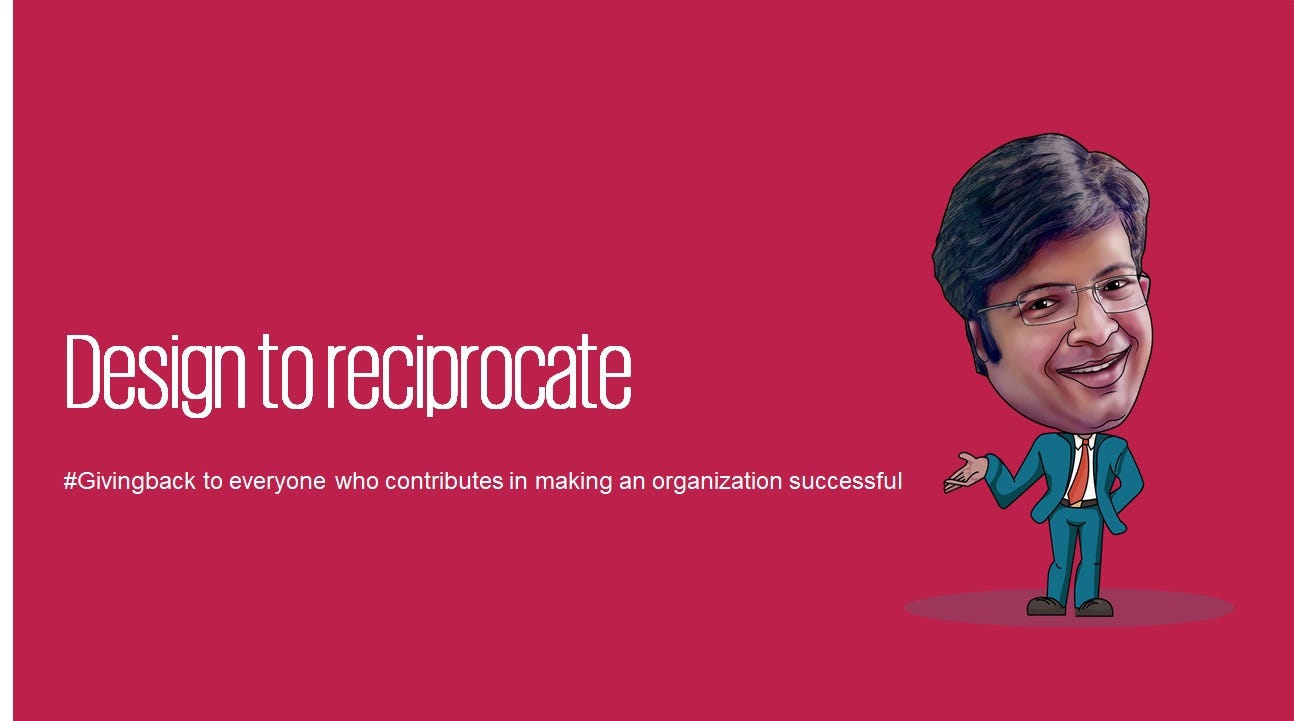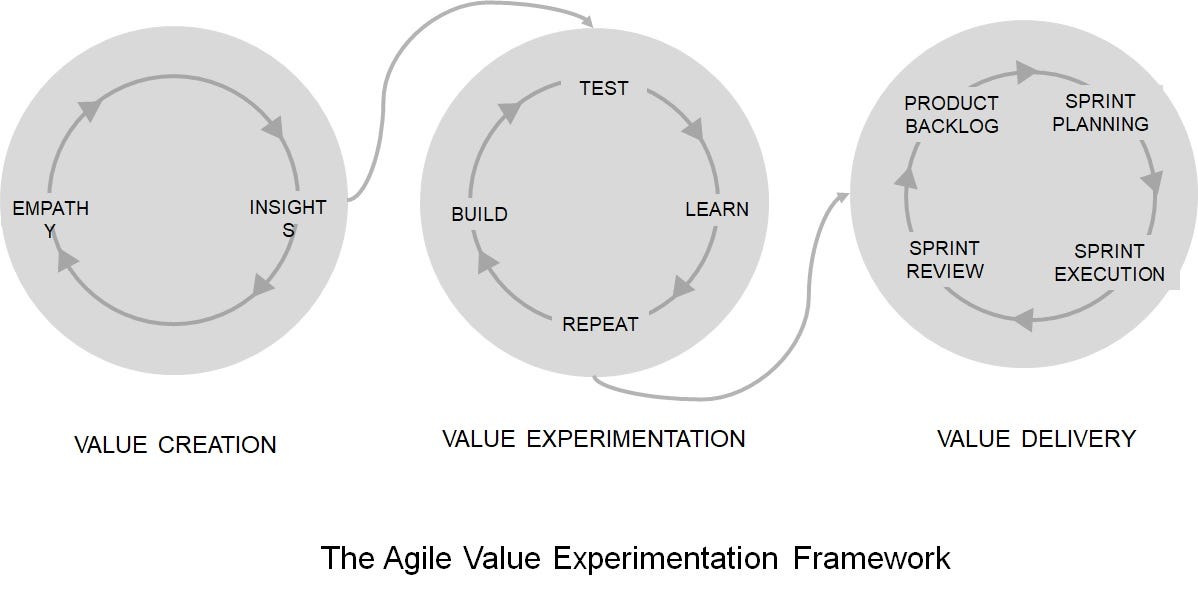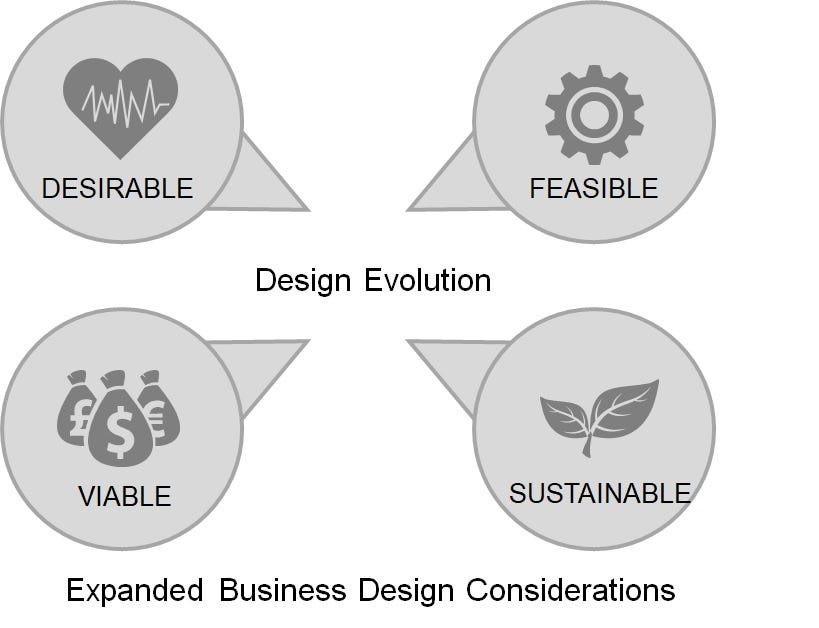Design to Reciprocate
#Givingback to everyone who contributes in making an organization successful

In continuation to my previous point of view on application of Design Thinking during this unprecedented time of COVID-19, here is my take on what organization should do to help design a better future.
This point of view has been written in three parts; this is PART TWO. Part one focused on changes that individuals need to make in their approach. The third part will focus on how governments can apply principles of Design Thinking to better manage these unprecedented times.
Introduction:
Let’s start by putting a context to Design Thinking, as I understand it …. A human obsessed approach to solving unprecedented and wicked challenges like COVID and others. Extremely effective in solving challenges that do not have historical references to learn from, and the only way to learn is by experimentation.
While there have been various frames used to describe Design Thinking, I think the best way to understand it, is by understanding and imbibing its three key principles.
· Empathy above everything
· Experimentation is the only way
· The journey of evolution never ends
So now taking the context of COIVD-19, most of the present-day organizations have never experienced something, that is of similar nature and magnitude. I sometimes mockingly mention, that if we go years back, most of the strategy and business plans used to mention ‘VISION 2020’ and today in 2020 none of the plans ever envisioned something like this could happen. This has left a key learning for organizations; planning is good however survival still lies in basics of human evolution.
While some organizations have been able to manage the change, a lot of them are still waiting for normal times to come back. However, the truth of the situation is that the old times may never come back. The present condition may bring a permanent change in consumer preference and behavior. This means that organization’s will also need to change their approach to designing products, services and business models.
Let’s try to look at the principles of Design Thinking and how should organization adapt themselves keeping the present context in purview.
Design Thinking for organizations:
I think organizations will need to change their way of seeing themselves in the traditional way from “A set of people trying to achieve a common objective” to a platform that is helping multiple players in the ecosystem to achieve their objectives and become successful. If they start looking at themselves as platforms, then let’s look at how the principles of Design Thinking will apply very differently but beautifully.
· Empathy above everything
In these testing times organizations will need to relook at their business models and think of themselves as platform, powering collaborative growth for customers, employees, vendors, government, communities, environment, shareholders and themselves.
To bring this change organizations will need to embed empathy in their ways of working. What I mean by embedding empathy is, understanding the stated and unstated needs and aspirations of various stakeholders while designing products, processes, services, interaction, technology, business models etc.
This has been further elaborated in the below diagram.

Empathizing with each of the ecosystem stakeholder can open wide range of opportunities that can help broaden an organization’s playing field. An organization can then look at designing specific value units by understanding their needs through empathetic immersion thus making itself timeless and a true hub of continuous value creation.
· Experimentation is the only way
This second principle is more applicable today than ever before. Gone are the times when organizations could look up to someone (A consultant OR competitor OR A leader) for answers for the business challenges that they are facing. TRULY !!! no one has an answer to the questions that this pandemic has posed to the industry. Everyone is in a similar zone of ambiguity and uncertainty.
I feel the pandemic has forced organizations to come out of their safety cover of tried and tested OR embrace what works to ‘agile experimenting’ of new value units that create functional, commercial and emotional value for all the stakeholders interacting with their brand.
This is explained further in the below diagram.

The overall organizational value lifecycle can be divided into three connected spaces. In the value creation space helps in continuously empathizing with stakeholders and define value units that can potentially create value. The value experiment space enables continuous experimentation on the defined value units and convert them into MVPs and POCs. In the value delivery space, the value units are delivered and operations is prepared to scale. Thus an organization that is able to create, experiment and deliver value continuously becomes an agile organization in the true sense.
· The journey of evolution never ends
The pandemic has raised many fundamental questions for organizations. One of them is “How might we re-design our business that helps deliver a better future for generations to come”. This is where the third and final principle applies, where organizations will have to rethink of their business designs to minimize impact on environment, so that such unprecedented times can be minimized or avoided.
This can be understood through the below diagram.

While taking business design decisions most of the organization’s used to have feasibility and viability considerations. I think this is a very short term approach and has led to more damage and less benefit. The future business designs will have to be at the sweet spot of four key considerations i.e.
Desirability — Will my design add functional, commercials & emotional value to my stakeholder’s life ?
Feasibility — Can the design be built, delivered and scaled?
Viability — Will my design make business sense? Not only for me but for all player in the ecosystem.
Sustainability — What is the impact of my design on environment? Can we minimize it?
My firm belief is that these three principles if contextualized and applied to organizations and industry can definitely help organizations in re-thinking thei business models and thus design a better planet for the generations that are still to inhabit it.
With hope, that the learnings of this pandemic will make organizations more empathetic and considerate of the future, I would like to end this second part of my article.
In the third part I will share my point of view on how governments can apply the principles of Design Thinking in these unprecedented times.
About the author, Ajay Aggarwal
A Haryanvi by origin, an entrepreneur at heart and a consultant by choice, that’s how Ajay likes to introduce himself! Ajay is the Founding Partner at Humane Design and Innovation Consulting (HDI). Before starting HDI, Ajay founded the Design Thinking and Innovation practice at KPMG India. His 16+ years of professional career spans across various roles in product and service design, conducting strategy workshops, storytelling and enabling an innovation culture. He has coached 50+ organizations and 2000+ professionals in institutionalizing design and innovation practices. He loves to blog and speak on topics related to Design Thinking, Innovation, Creativity, Storytelling, Customer Experience and Entrepreneurship. Ajay is passionate about learning, writing poems and visualizing future trends!
We at Humane Design strongly believe in the human ethos and draw inspiration from humans and other elements of nature to design innovative solutions for organizations of all sizes. We will be glad to be your success partner. Email us your requirements at explore@humaned.in.



